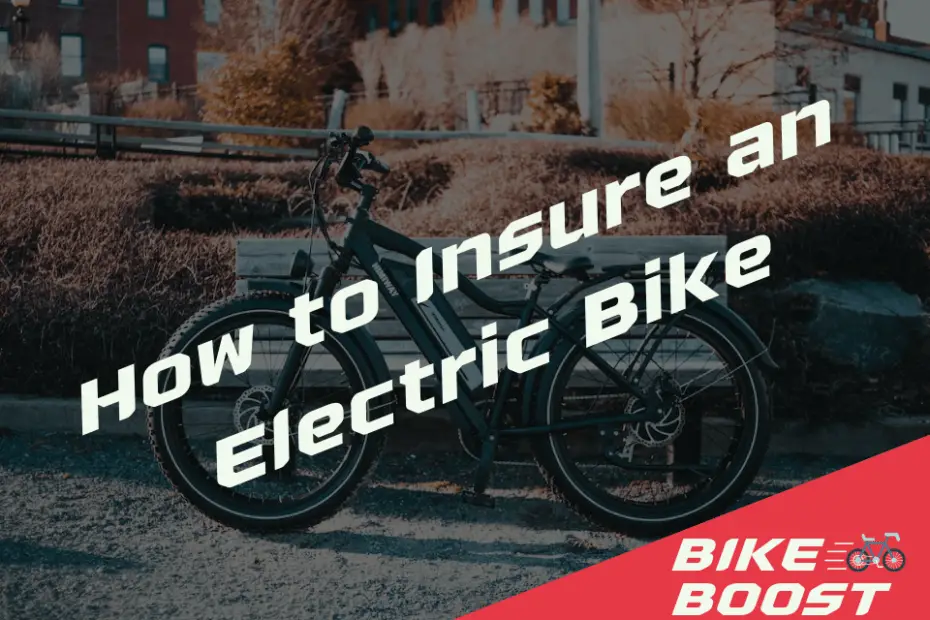We love writing these guides for you and sometimes we are compensated when you use one of our links to buy a product. This doesn’t impact the final price you pay. If you want to learn more about how this works, please see our Affiliate Disclosure page.
As an avid cyclist or someone considering venturing into the world of electric bikes, you understand the importance of protecting your valuable investment. Insuring your electric bike is a smart and responsible decision that provides peace of mind and financial security. In this comprehensive guide, we will walk you through the process of insuring your electric bike, ensuring you have all the necessary information to make informed decisions and choose the right insurance policy.
Understanding E-Bike Insurance
E-bike insurance serves as a safeguard, offering coverage against potential risks and uncertainties associated with owning and riding an electric bicycle. Similar to traditional bicycle insurance, e-bike insurance provides protection for theft, accidents, damage, and even liability.
Evaluating Your Insurance Needs
Before diving into the intricacies of e-bike insurance, it’s essential to evaluate your specific insurance needs. This evaluation helps determine the type and level of coverage that will suit you best. Consider the following factors:
- Value of Your Electric Bike: Determine the current market value of your electric bike. This evaluation will assist you in estimating the appropriate coverage amount.
- Riding Habits and Usage: Reflect on how frequently and where you plan to ride your e-bike. Will you mainly use it for commuting, leisurely rides, or adventurous off-road trails? Understanding your riding habits is crucial in choosing the right insurance policy.
- Local Regulations: Familiarize yourself with the laws and regulations in your area regarding e-bike insurance. Certain regions may have specific requirements or restrictions.
Now that you have a clear understanding of your insurance needs, let’s explore the different types of e-bike insurance available.
Types of E-Bike Insurance
1. Liability Insurance
Liability insurance protects you from potential lawsuits and claims arising from accidents involving your electric bike. This coverage ensures that if you are responsible for causing bodily injury or property damage to a third party, you have financial protection.
2. Theft and Damage Insurance
Theft and damage insurance provide coverage in case your electric bike is stolen, vandalized, or damaged due to accidents or other covered incidents. This type of insurance ensures that you won’t face a significant financial burden if your e-bike needs repair or replacement.
3. Comprehensive Insurance
Comprehensive insurance combines liability, theft, and damage coverage into one comprehensive policy. It offers all-around protection, giving you peace of mind knowing that your electric bike is covered in various scenarios.
Choosing the Right Insurance Policy
When selecting an insurance policy for your electric bike, it’s important to consider several key factors:
- Coverage Limits: Ensure that the policy offers sufficient coverage for the value of your e-bike. Additionally, review the liability limits to protect yourself adequately in case of an accident involving a third party.
- Premium Costs: Compare premium rates from different insurance providers to find the best balance between coverage and affordability. Be mindful of any discounts or incentives that may be available.
- Exclusions and Deductibles: Understand the policy’s exclusions and deductibles. Exclusions refer to specific situations or circumstances where the insurance may not provide coverage. Deductibles are the out-of-pocket amount you must pay before the insurance coverage kicks in.
Insuring Your Electric Bike: Step-by-Step Guide
Now that you have a good understanding of e-bike insurance and the types of coverage available, let’s dive into the step-by-step process of insuring your electric bike.
- Research Insurance Providers: Begin by researching reputable insurance providers that offer e-bike insurance policies. Look for providers that specialize in bicycle insurance or have specific coverage options for electric bikes. Websites like BikeBoost.org offer valuable resources and comparisons to help you find the right insurance provider.
- Gather Information: Before contacting insurance companies, gather all the necessary information about your electric bike. This includes the make, model, year, and any modifications or accessories added to your bike. Having this information readily available will expedite the insurance quote process.
- Request Insurance Quotes: Reach out to multiple insurance providers and request quotes for insuring your electric bike. Provide them with accurate and detailed information to ensure the quotes reflect your specific needs. Consider factors such as coverage limits, deductibles, and premiums when comparing quotes.
- Review Coverage Details: Once you receive the quotes, carefully review the coverage details of each policy. Pay close attention to the specific coverage areas, limitations, and exclusions. Look for policies that offer comprehensive coverage for theft, damage, liability, and any additional features you require.
- Consider Additional Coverage: Depending on your individual needs, you may want to consider additional coverage options. For example, if you frequently ride in high-theft areas, you might consider additional anti-theft coverage. Evaluate the available options and choose the ones that provide the most comprehensive protection for your electric bike.
- Make an Informed Decision: After evaluating the insurance quotes and considering the coverage details, it’s time to make an informed decision. Select the insurance policy that best aligns with your requirements, taking into account factors such as coverage, cost, reputation of the provider, and customer reviews.
- Contact the Insurance Provider: Once you’ve made your decision, contact the chosen insurance provider to initiate the insurance policy. They will guide you through the application process, answer any questions you may have, and provide the necessary paperwork.
- Review the Policy: Before finalizing the insurance agreement, carefully review the policy documents. Ensure that all the details, coverage limits, deductibles, and terms are accurately reflected in the policy. Seek clarification from the insurance provider if anything seems unclear.
- Pay Premium: Pay the premium for your e-bike insurance policy as per the agreed-upon terms. Some insurance providers may offer flexible payment options, such as monthly or annual payments. Choose the payment plan that suits your financial situation.
- Keep Records: Once your electric bike is insured, keep copies of all the relevant insurance documents, including the policy, payment receipts, and contact information for the insurance provider. It’s also a good practice to maintain records of any modifications made to your e-bike or significant upgrades.
By following these steps, you can ensure a smooth and hassle-free process of insuring your electric bike. Remember to periodically review your insurance policy to ensure it still meets your needs as your riding habits and bike accessories may change over time.
Enjoying Peace of Mind with Electric Bike Insurance
Congratulations! You’ve successfully insured your electric bike, and now you can ride with confidence knowing that you have the necessary protection in place. Electric bike insurance provides you with peace of mind and financial security in case of unexpected incidents. Here are some key benefits and tips to make the most of your e-bike insurance:
- Coverage for Theft and Damage: With electric bike insurance, you have coverage against theft, damage, and vandalism. In case your bike gets stolen or is involved in an accident, your insurance policy will help cover the repair or replacement costs, minimizing the financial burden on you.
- Liability Protection: Electric bike insurance often includes liability coverage, which protects you in case you cause damage to someone else’s property or injure someone while riding. This coverage can be invaluable, especially in situations where legal expenses and compensation claims may arise.
- Emergency Assistance: Some insurance policies offer emergency assistance services, providing you with support when you need it the most. Whether you require roadside assistance, towing, or transportation in case of a breakdown, these services can help you get back on track quickly.
- Peace of Mind: One of the greatest benefits of e-bike insurance is the peace of mind it offers. Riding an electric bike is meant to be enjoyable and worry-free, and having insurance ensures that you can focus on the ride without constantly worrying about potential risks and expenses.
- Regular Maintenance and Care: Along with insurance coverage, it’s essential to maintain and care for your electric bike properly. Regularly check your bike’s components, ensure tires are properly inflated, and keep the battery charged. Following maintenance guidelines will not only keep your e-bike in excellent condition but also help prevent accidents or mechanical issues that could lead to insurance claims.
- Stay Informed: Keep yourself updated with the latest safety regulations, road rules, and any changes in e-bike insurance policies. Being aware of any updates or modifications will help you maintain compliance and ensure your insurance coverage remains valid.
Remember, while insurance provides protection, it’s crucial to ride responsibly and take necessary precautions. Always wear a helmet, follow traffic rules, and be mindful of pedestrians and other road users. Safe riding habits combined with insurance coverage offer the best combination for a secure and enjoyable e-biking experience.
If you ever have any questions or need assistance with your electric bike insurance, don’t hesitate to reach out to your insurance provider. They are there to support you and provide guidance whenever you need it.
FAQs
Can I turn my bike into an electric bike?
Yes, it is possible to convert your regular bike into an electric bike. By adding an electric bike conversion kit, you can enjoy the benefits of electric assistance while retaining the basic structure of your existing bike.
Can you charge an e-bike while riding?
Generally, it is not recommended to charge an electric bike while riding. Most electric bikes require you to plug them into a power source to charge the battery fully. However, regenerative braking systems are available in some models that partially recharge the battery when you brake or descend hills.
Can I ride an electric bike on the sidewalk?
The rules regarding riding electric bikes on sidewalks vary depending on your location. In some areas, it may be allowed, while in others, it is restricted or prohibited. It’s important to check the local laws and regulations to determine where you can legally ride your electric bike on the sidewalk.
Can you drive electric bikes on the road?
Electric bikes are generally allowed on the road, but specific regulations may vary. In many jurisdictions, electric bikes that meet certain criteria, such as maximum speed and power limits, are classified as bicycles and can be ridden on roads alongside traditional bicycles. However, it’s essential to familiarize yourself with local traffic laws and any specific regulations pertaining to electric bikes on the road.
Which is better: electric bike or electric scooter?
The choice between an electric bike and an electric scooter depends on your personal preferences and needs. Electric bikes provide pedal-assisted power, allowing you to enjoy both exercise and electric assistance. On the other hand, electric scooters are typically more compact and require less physical effort. Consider factors such as distance, terrain, and desired riding experience to determine which option suits you best.
How do electric bikes work?
an electric motor. They are equipped with a rechargeable battery that powers the motor, providing assistance to the rider when pedaling. The level of assistance can usually be adjusted, allowing riders to control the amount of electric power they receive.
Andy is an avid cyclist who enjoys nothing more than a ride out in the hills. Competing in track, road, time trial and mountain bike events in the past, he prefers slower rides out with his family these days.

